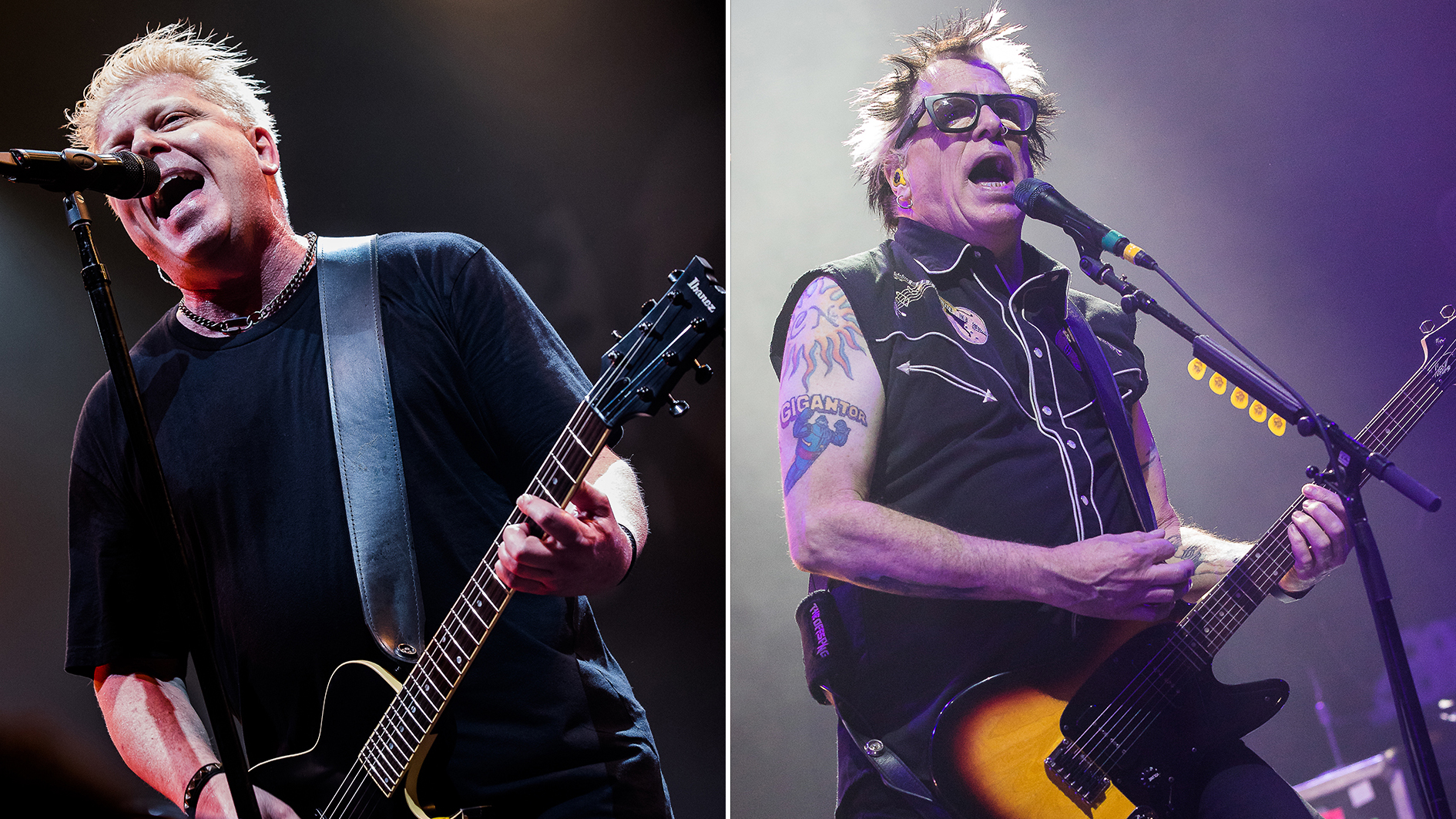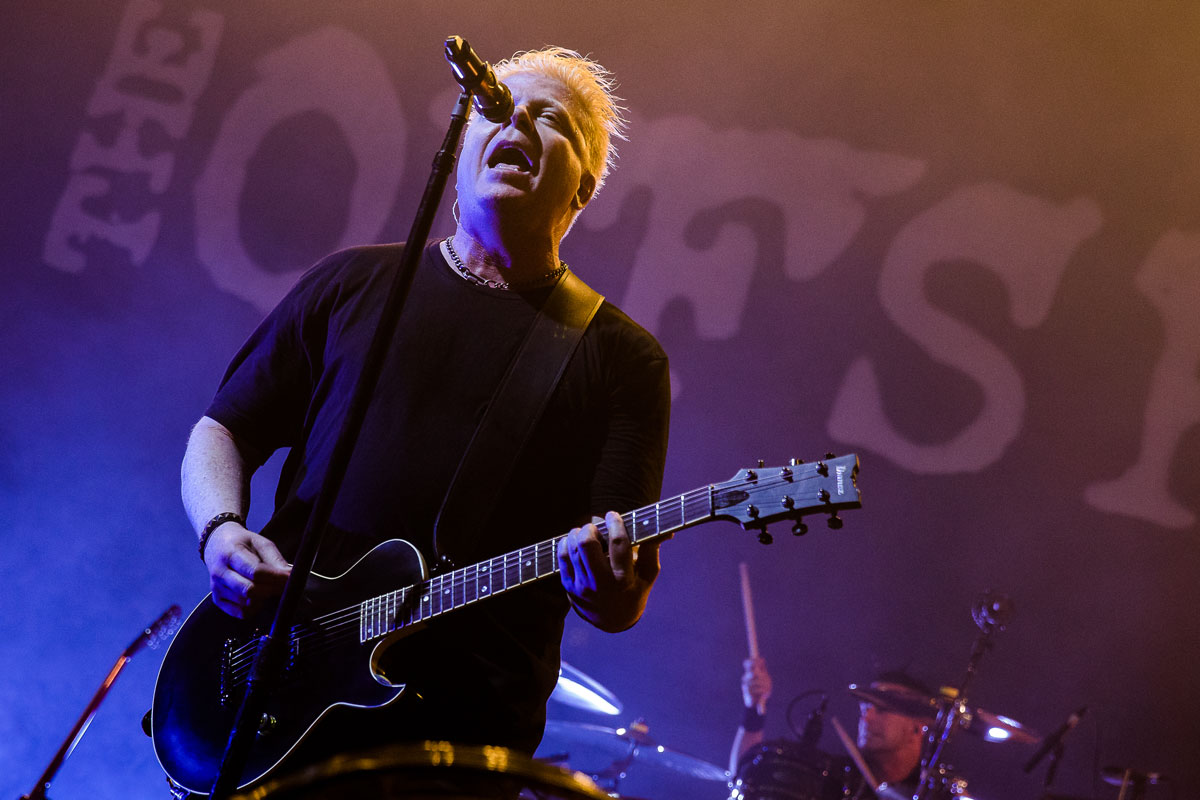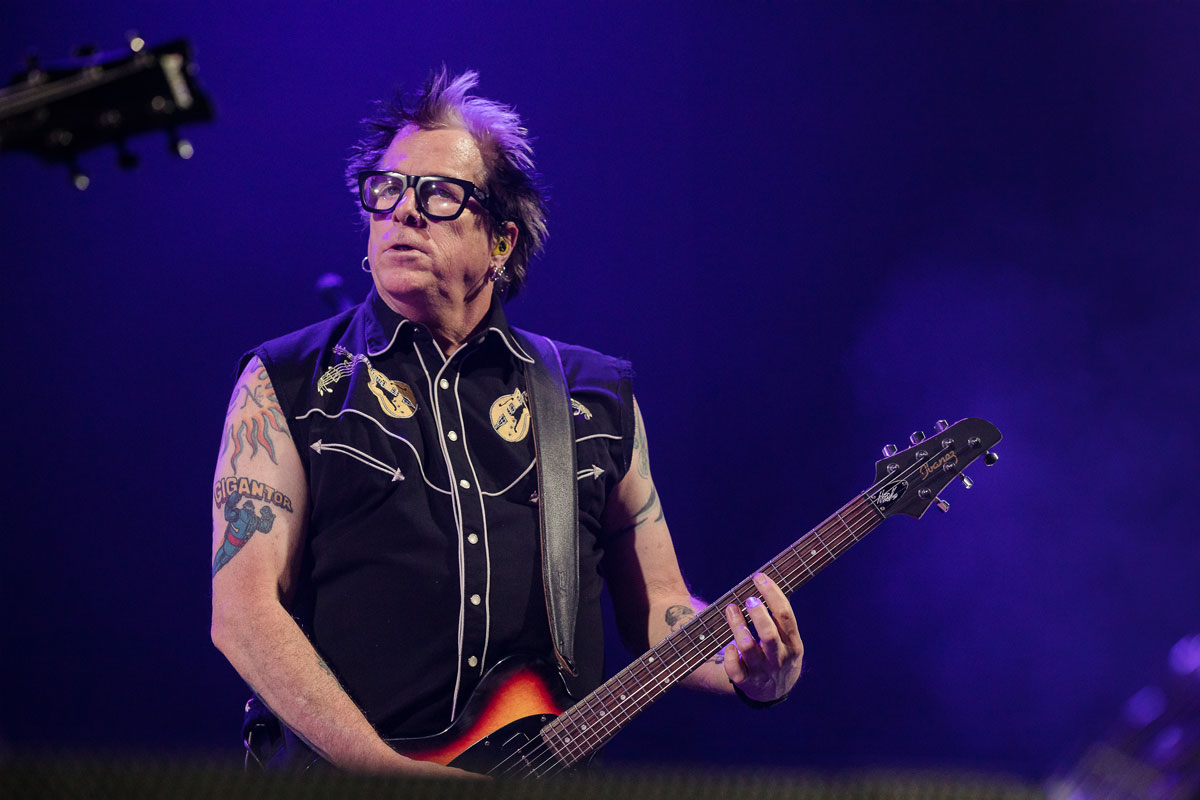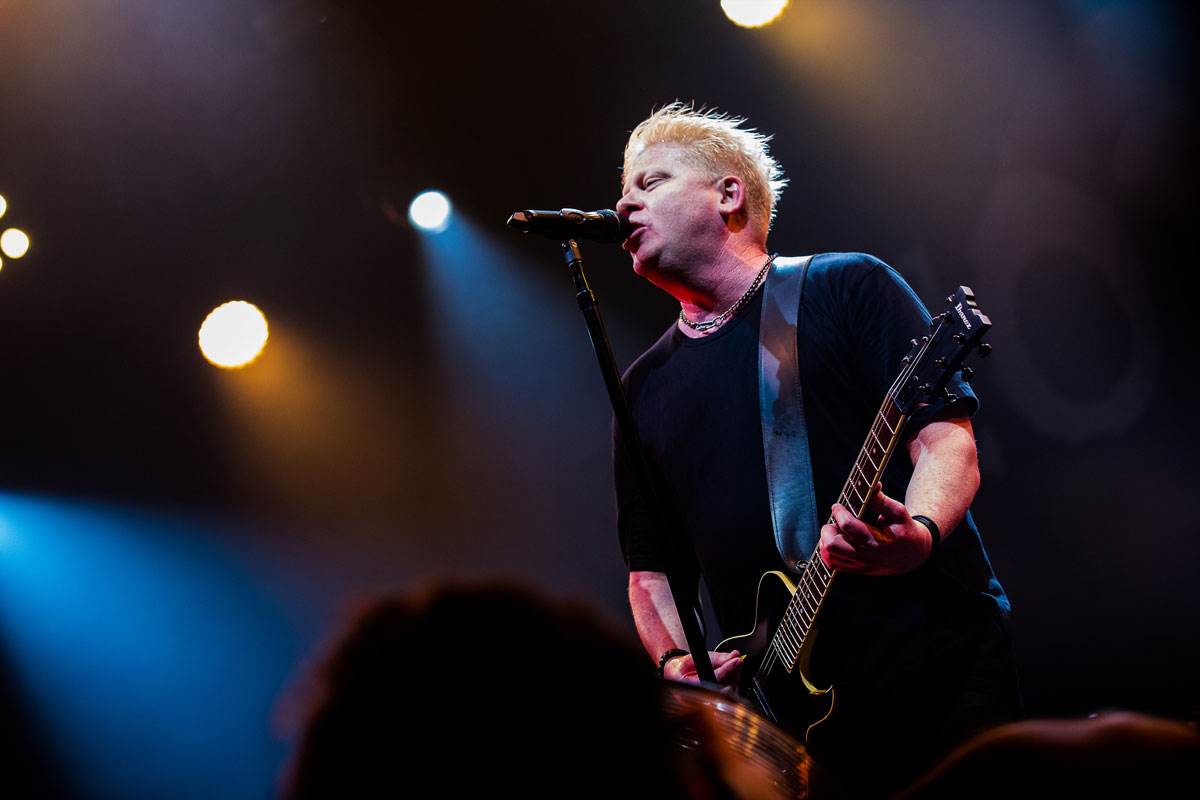The Offspring: “We wanted to go back to basics: heavy guitars, bass and drums – and a melodic song underneath all that”
Dexter Holland and Noodles talk production tips from Bob Rock, how to dial in a great punk-rock tone and the gear behind new album, Let The Bad Times Roll

Originally formed as Manic Subsidal in 1984, The Offspring have become one of the biggest-selling bands in punk-rock history. So, naturally, if any of us were thinking about starting a punk group today, they’d be in a good position to offer up some pearls of wisdom on the matter...
“My first tip would be don’t play the drums,” laughs singer/guitarist Dexter Holland. “You don’t want to be the drummer – it’s the most thankless job. You gotta haul all that gear around. Your buddies will say they will help you break down the kit but they won’t... They will pack their guitars away and leave.
“So be a guitar player – chuck it in the case and you’re out the door! I also would say embrace technology. Try things like the Fractal [Axe-Fx] – it’s all really good these days.”
His bandmate Kevin John Wasserman, better known as Noodles, also has some words to offer on the subject, listing two key players that every punk guitarist can learn from.
“I would say study Johnny Ramone’s playing as much as you can,” he grins. “But don’t forget to also study [Dead Kennedys guitarist] East Bay Ray’s playing. They’re both incredible punk-rock musicians but very different. There are a lot of ways to make a guitar sound punk. Be simple but don’t oversimplify it – get as creative as you want.”
The pair are talking to Guitar World today to promote upcoming tenth album Let The Bad Times Roll – a mishmash of the frenetic guitar sounds and poppy hooks that made them world-renowned.
It’s been a long time coming – the group actually started working on the new recordings some eight years ago. After changing record labels, re-recording tracks numerous times in multiple locations, a lawsuit involving ex-bassist Greg K – who has been since replaced by Todd Morse – and, of course, a world pandemic, they’re back to doing what they do best.
Get The Pick Newsletter
All the latest guitar news, interviews, lessons, reviews, deals and more, direct to your inbox!
Here, Holland and Wasserman talk us through the gear heard on the new music and the inexhaustible supply of studio tricks they’ve managed to pick up from longtime collaborator/producer Bob Rock…
What felt different from a guitar perspective on this record?
Noodles: “Guitars are always important to us. With this record we did kinda want to go back to the basics and do an album that sounded like The Offspring. Heavy guitars, bass and drums, and usually a melodic song underneath all that. Though we also wrote a song with horns on it and a song that was all piano. Other than that, it’s pretty much all guitars [laughs].”
Holland: “It’s all over the place! You can do so much with guitars, but if you have a really heavy track and put one that’s semi-distorted underneath, it can really change that whole vibe and flavor. It can make it sound thicker or gloomier or however you may want it to sound.
“Even on a song like We Never Have Sex anymore, we still have those… I don’t know what you call them. Licks?!”
Noodles: “Just call them licks, I guess!”
Holland: “But there’s an art to making them sound good. You don’t want everything super-distorted; it’s got to have a little bit of a bite to it – that’s how you make it sound good. We’re always tinkering away with those kinds of things and Bob Rock is so good at that stuff in particular… he’s a guitar guy first and foremost.”
It must be fun picking the brains of someone with that kind of experience…
Noodles: “We’ve been picking his brains for 12 years now. We’re like vultures on a carcass. [laughs] Bob’s great for that, because he loves talking about things and he’s always learning himself, too. Whenever he finds a box or piece of equipment or even just a fact he learned about an old piece of music, we talk about all that.
Guitars are always important to us. With this record we did kinda want to go back to the basics and do an album that sounded like The Offspring
Noodles
“He loves sharing the information. We love to hear it – especially about guitar stuff. He’s a player himself and loves guitar sounds. He really has an encyclopedic knowledge about all that.”
So what kinds of things have you learned from him?
Noodles: “Bob encourages us to experiment. He’ll bring in different boxes and sounds, which we’ll plug into different amps. If we’re not getting something we love, we’ll completely change gears and try something else.
“We’ll go through our warehouse, look at what we have in there and bring them in to swap other things out. That’s how we get different sounds.”
Holland: “To be perfectly honest, in the past we’ve gotten completely carried away. We’ve had 12 different guitar tracks on one song. I had a conversation with Bob and said, ‘Let’s not do that this time! Let’s just get a couple of good sounds – there’s something pure about that.’ I wanted to be a bit more straightforward. We ended up splitting the difference, it wasn’t quite one or the other.
Noodles: “A lot of times you’ll go overboard and then kinda dial it all back. You need to realize you’ve gone too far and taken this ship all the way off the edge of the earth – that’s when you can come back and figure out what works best for the song.”
How exactly did you split your guitar duties on the new album?
Noodles: “A lot of the time things are being written to tape! Like, ‘Here’s an idea I’ve got!’ and we’ll play it and record. That will be Dexter most of the time. Sometimes I’ll come in and redo it later and on other tracks I might just leave it.
“Other times Dexter might have an idea but his sound or playing might not suit it. And I’ll be in the other room hearing him trying to do something and say, ‘Yeah, that’s a me part!’
“So I’ll come in and we’ll work together on making it sound like how he envisions it and how I approach it, making it mesh. A lot of times, once the song is written I’ll come in and add guitars there.”
Holland: “It’s surprising how you put things down rough thinking you’ll fix it later and you end up keeping a lot of those takes. I don’t know if it’s because your ear gets used to it or you like the fact that it’s not quite perfect, it’s a little rough around the edges or whatever. But sometimes those first takes end up being the one.”
If you go out and buy a Tube Screamer, it might not sound as good as famous ones from the past…
Dexter Holland
Noodles, it looks like you are playing your newest signature, the Ibanez NDM5, in the video for the title track…
Noodles: “Yeah! There was only a little bit of difference between the NDM4 and NDM5, I think it’s the pickups primarily. They’re both sunburst models, I guess they’re calling it the NDM 5 after the pickup upgrade – now they sound nicer and a bit hotter. I like the new ones more.”
They look like P-90s but they’re single coils, right?
Noodles: “Yeah. We gotta call them soapbars because P-90 is a trademarked name and these aren’t those ones. But yeah, single-coil soapbar pickups which you could say have a similar kind of growl.”
What kind of pedals did you have in the studio with you for the recordings?
Noodles: “The main pedal we used was a Tube Screamer…”
Holland: “Yes, the good old Tube Screamer [laughs]!”
Noodles: “We’ve got quite a few lying around. Most of ours are vintage. Bob has one or two with the Keeley mod.”
Holland: “That’s the weird stuff you get into that I probably should know more about but don’t. If you go out and buy a Tube Screamer, it might not sound as good as famous ones from the past…”
Noodles: “We have some of the older ones which are like the Holy Grail for Tube Screamers and then we also have some other modded ones too. We don’t always have them in the chain, but for a lot of it we do, adding our own tweaks and twists to make it sound good.”

And as for amps, you’ve used Diezels, Marshalls and Bogners in the past – was it more of the same this time round?
Holland: “Yeah! We are usually playing through multiple amps at the same time. In the studio we’re sitting in right now there’s a Marshall, a Diezel, a Mesa/Boogie. It was actually Bob who turned us on to the Diezels, he’d used them a lot with Metallica I think…”
Noodles: “I didn’t know the Metallica connection! There’s a Bogner around here somewhere too. We’re always swapping them in and out.”
Holland: “We’re also using amp modelers now as well, because they match things pretty closely.”
And Dexter, what kind of guitars did you end up sticking with?
Holland: “I’ve got one main workhorse. It’s a 1965 SG Junior that has an amazing sound. We kinda have this philosophy – if we like a guitar, we don’t try to get the pristine version, we get the beat-up version. It sounds just as good and you don’t have to spend $50k on a guitar. We call them ‘beaters’. We actually play these things!”
Noodles: “They’re not wall-hangers…”
We have this philosophy – if we like a guitar, we don’t try to get the pristine version, we get the beat-up version. It sounds just as good and you don’t have to spend $50k on a guitar
Dexter Holland
Holland: “At points in the past we’ve talked about having some nice kind of Gretsch, so we’ll do that and have that Malcolm Young sound. Over years we’ve accumulated all these different guitars – you can find pretty much anything you’re looking for, from Strats and Teles to Gibsons.”
So what are the most prized instruments in the collection?
Holland: “Definitely this SG here, because it sounds so great. I play Ibanez mostly live, because they sound great and travel well. A lot of these old fancy guitars sound great but they’re sorta fragile, if you know what I mean? It’s a little tough to take them on tour…”
Noodles: “We use most of our vintage guitars here in the studio, though we really wanted to take them out on the road with us.”
Holland: “I wanted to have an old cool guitar so I bought the Keith Richards. Which one was it again?”
Noodles: “The 355, with the Bigsby on it and the five position dial.”
Holland: “But I’m thinking of trying it out as my new live guitar, it’s my baby at the moment!”
Noodles: “I got you beat, though…”
Holland: “What have you got?!”
Noodles: “I have my 1956 Gretsch Sparkle Jet, which is here with us now. We used it on a few things on this record. And then I also have a ‘65 Strat that’s just gorgeous… it sounds like butter and it plays like butter.”
Holland: “Okay. He’s got me beat.”
Noodles: “Your 355 is pretty bitchin, though!”

Americana was the album that saw you embracing more poppy concepts and leaving some of the punk aggression behind – similar things can be said of songs like the title track on your latest…
Noodles: “With that single, though we didn’t really imagine it in the pop charts, we did kinda want to give the chorus that kind of feel. It’s that dichotomy of all this shit happening in the world, but at the same time you gotta roll with it and figure out how to have an enjoyable and meaningful life.
“That’s why the chorus is upbeat and dance-y, with clean and acoustic guitars, but the gritty and bite-y guitars through the verses. It was all about changing the mood.”
Ixnay on the Hombre, however, felt like more of a thrash-metal guitar assault at points. What’s the secret to the techniques at play in those faster punk riffs?
Noodle: “The hardest one early on was L.A.P.D. off Ignition because of the down-strokes.”
Holland: “We love that technique, when you mute the guitar and you’re only hitting down. That was such a huge element in all the early punk stuff we listened to. It comes down to practice for sure. Live, we actually try to do songs faster than the record.”
Noodles: “It reminds me of [T.S.O.L. drummer] Todd Barnes’ hitting the ride cymbal with his right hand. We were matching that with our guitars.”
Holland: “It brings this tension. Of course, the metal guys do it too at a slower pace. A great example is when The Dickies did Paranoid. It had the same down-stroking thing but they did it twice as fast. I thought that was so cool… I always loved that vibe.
When you take tube amps out, the electricity, the floor, the walls… it all changes drastically from night to night. The Axe-Fx doesn’t seem to change at all
Noodles
“We incorporated that into our songs, and – like you said – a lot of it was on Ixnay on the Hombre. The heaviness and hint of metal was down to Dave Jerden, our producer at the time. He had just come off of Alice In Chains and other really heavy metal stuff, so he brought that kind of sound into the studio on that record.
“It was great working on that and I really appreciated the tones he got for us. I don’t think we could have gotten it on our own. He got us into Bogner… that was the amp for the record, I think!”
Noodles: “And I still use them, quite a few of my rhythm tracks were done with a Bogner. These days we play venues where everything is booming and echoing. To sound tight, we really have to work on your strumming. Some parts we’ll even simplify to focus on the oomph. It’s worth thinking about to keep more power in the live arena.”
Speaking of your live rigs, you’ve mainly stuck with Axe-Fx in recent years. It’s easy to see why – it’s remarkably versatile and efficient…
Noodles: “It is! And it doesn’t change from night to night. And like we mentioned, we’ll even use it a little for recording, though always tube amp primarily. We can make the Axe-Fx sound exactly the same for our live shows and it never changes.
“When you take tube amps out, the electricity, the floor, the walls… it all changes drastically from night to night. The Axe-Fx doesn’t seem to change at all. It sounds great.”
Holland: “What’s an Axe-Fx?”
Noodles: “Axe-Fx is the Fractal.”
Holland: “Oh, okay [laughs].”
Noodles: “We have two signals – one going to the front of house and the monitors, and the other going to my cabinet so I can get good feedback on stage. So we use them in multiple ways and they always sound great.”
Holland: “The technology is incredible. We were really reluctant to go that way, it didn’t sound right at first. We play tube amps for a reason. We’re not trying to be most high-tech, we want it to sound good. But it came down to evolution.”

Do you remember the moment you decided it could be worth it?
Holland: “We were using tube amps and running Iso-Cabs – I think Bob turned us on to those as well – and they are the giant roadcases with a speaker permanently mounted inside with the mic. It’s all enclosed so you don’t get any bleeding.
“They’re not supposed to change as much night-to-night, they do a bit, though it’s generally pretty good. But we were hauling around a truckload of refrigerators to make that stuff happen. When the Fractal stuff came along, I was really pessimistic, but it’s amazing how good they sound.”
Noodles: “We started using them for one-offs here and there. All our stuff would be overseas in two different continents, so we’d take the Fractals out. The more we did it, the more we liked how they sounded.
“We were shipping half the shit out and it was consistent. Then we started experimenting, building more sounds on them and even using Kempers in some instances. They sound great every night, so why wouldn’t we use them more and more?”
Finally, what are the secrets to nailing a good punk rock tone – does it come down to thicker strings, less bottom-end, scooped mids or anything else?
Noodles: “For strings, I’ve been using 11s, though I might switch to 10s for the live shows. The bendy stuff is usually me, Dexter’s more into sliding up and down. We might mix it up with heavy bottoms, lighter tops. That helps for the barre chords, makes them feel a bit bigger. Other times, depending on the type of chord, you might want the lighter strings.”
Holland: “We like the heaviness, of course. The problem is when you make songs faster and faster, you can’t distinguish much in all the heaviness. It gets real thuddy. We have to dial in and EQ right in order to get that articulated guitar sound. So yeah, we’ll dial back the bass a little bit. We want to be serious…”
Noodles: “Is that when we up the 5k?”
Holland: “Yes [laughs]! There’s a big weird secret in the industry: when you’re in doubt, boost the 5k [laughs]!”
- Let the Bad Times Roll is out on April 16 via Concord Records, and available to preorder now.
Amit has been writing for titles like Total Guitar, MusicRadar and Guitar World for over a decade and counts Richie Kotzen, Guthrie Govan and Jeff Beck among his primary influences as a guitar player. He's worked for magazines like Kerrang!, Metal Hammer, Classic Rock, Prog, Record Collector, Planet Rock, Rhythm and Bass Player, as well as newspapers like Metro and The Independent, interviewing everyone from Ozzy Osbourne and Lemmy to Slash and Jimmy Page, and once even traded solos with a member of Slayer on a track released internationally. As a session guitarist, he's played alongside members of Judas Priest and Uriah Heep in London ensemble Metalworks, as well as handled lead guitars for legends like Glen Matlock (Sex Pistols, The Faces) and Stu Hamm (Steve Vai, Joe Satriani, G3).
“I always felt like that record could have been better if we had worked on it some more”: Looking for a blockbuster comeback album, Aerosmith turned to Van Halen producer Ted Templeman. For Joe Perry, it served as a learning experience
“It's like saying, ‘Give a man a Les Paul, and he becomes Eric Clapton. It's not true’”: David Gilmour and Roger Waters hit back at criticism of the band's over-reliance on gear and synths when crafting The Dark Side of The Moon in newly unearthed clip











